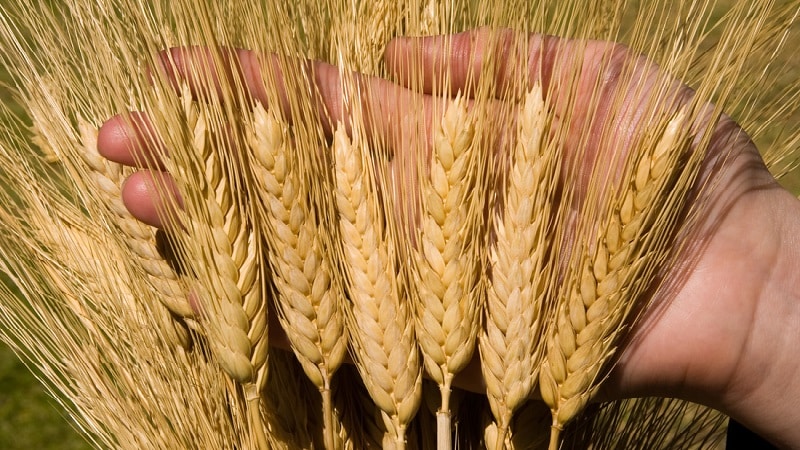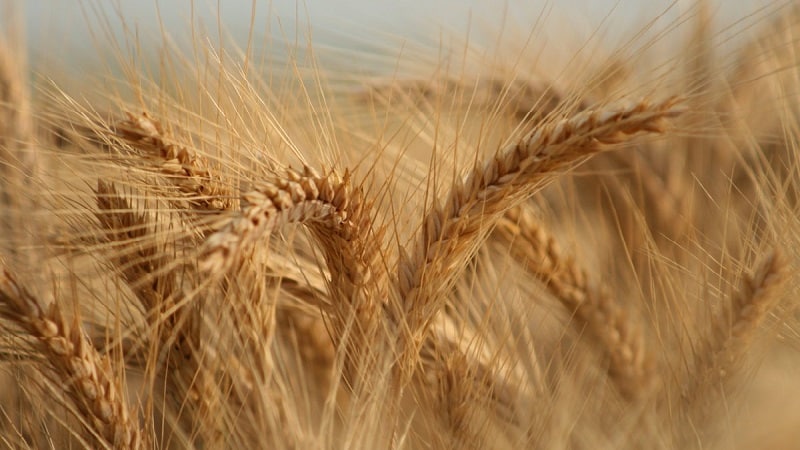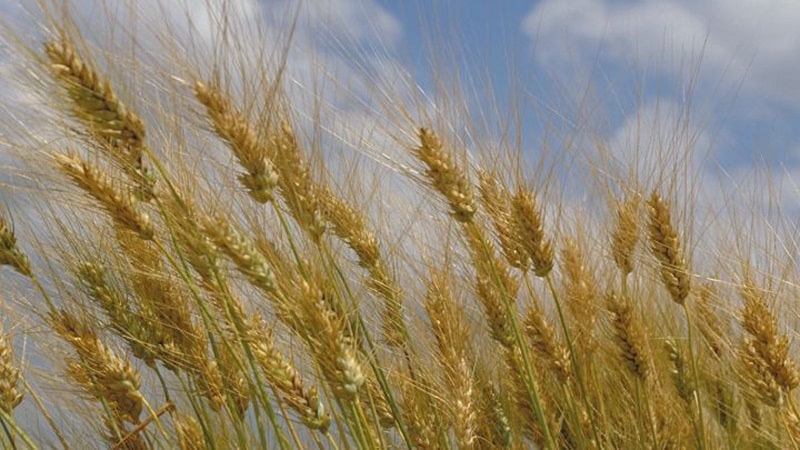What is durum wheat: description, scope of application and differences from soft varieties
Of all types of wheat, durum wheat is the most useful. It is rich in gluten, fiber, silicon, boron, manganese, selenium, vitamins K, PP and group B. It is grown in areas with a continental climate where summers are hot. Let's look at what durum wheat is and how it differs from soft wheat.
What it is
Popular types of cereals:
- soft - Triticum aestivum;
- hard - Triticum durum;
- spelled — Triticum dicoccum;
- spelled - Triticum spelta.
Durum wheat (from the Latin Durum) contains from 18 to 36% gluten. Used to prepare pasta and cereals.
Botanical description
Annual plant 50–150 cm high. Stems are erect, culm with nodes and internodes. The leaves are flat, alternate, two-rowed, up to 20 mm wide. The root system is fibrous.
Inflorescence - a complex spinous spike up to 15 cm in length. The awns are parallel to the spike shaft. The fruit is a naked or membranous kernel. The grain is compressed from the sides, ribbed, glassy. The color is brown or yellowish.

Historical reference
Wheat is one of the first domesticated cereals, which began to be cultivated at the beginning of the Neolithic revolution. In ancient times, they used a wild-growing form, which crumbled when ripe and did not allow harvesting. Therefore, people used unripe grains.
The process of wheat domestication took a long time and was the result of accidentsrather than targeted selection.The area of origin of the common cereal is considered to be the countries in the east of the Mediterranean Sea. Then the culture appeared in India, Ethiopia, the Iberian Peninsula and the British Isles. During the period of the Roman conquests, wheat began to be grown in Europe.
Interesting things on the site:
How is durum wheat different from soft wheat?
The species share common characteristics, but there are some differences:
- In hard varieties, the stem is filled with loose parenchyma and the grain is small. In soft ones it is larger, the stem is hollow.
- Soft wheat is grown in regions with guaranteed precipitation (Australia and Western European countries), hard wheat is grown in areas with a drier climate, in the steppes: in Kazakhstan, in the south of Western Siberia, in Canada, North America.
- Durum flour contains a lot of gluten, the starch grains are hard and small. Kneading dough requires a lot of water. All types of pasta and cereals are made from this grain. In soft cereal flour, the grains of starch are larger and softer, there is less gluten, and little water is required. This wheat is suitable for making fluffy dough.
- In terms of productivity, the hard variety is inferior to the soft variety by 2–5 c/ha, but it is less susceptible to diseases and pests and almost does not crumble.
Reference. 80% or more of durum wheat on the Russian market comes from the Orenburg region.
Grain composition
The grain is characterized by increased glassiness of the endosperm (70–90%) and high-quality gluten. The crystalline form of starch is not destroyed during grinding. Protein content - from 13 to 23%.
The aleurone layer of grain is rich in water-soluble vitamins B1, B2 and especially PP.. There are vitamins B6, K, E, A, beta-carotene.

Classification
Types of wheat are distinguished according to botanical characteristics (soft, hard, white-grain, red-grain) and the nature of the crop (spring and winter). They are divided into subtypes depending on the color of the grain and the percentage of glassiness.
Spring durum wheat happens:
- dark amber (vitreousness - not less than 70%);
- light amber (vitreousness is not standardized).
Durum varieties are divided into 5 classes:
- Does not contain impurities of other types of grain more than 10%, including no more than 2% of white grain wheat. Vitreousness - no less than 70%, humidity - 14.5%.
- Other types of impurities make up no more than 10%, including no more than 4% of white grain varieties. Grain moisture content is 14.5%, glassiness is 60%.
- Humidity - 14.5%. Impurities - 10%, including no more than 8% of white grain varieties. Vitreousness - no less than 50%.
- The humidity and percentage of impurities are similar, but white grain - up to 10%. Requirements for glassiness are reduced to 40%.
- Humidity - 14.5%, impurity content and glassiness are not regulated. Class 5 wheat is used as feed.

Milling properties
Flour-grinding properties manifest themselves during the processing of grain into flour, affecting its quality and yield. The following indicators are used to determine:
- yield and quality of flour;
- the amount of grains extracted and their ash content;
- the degree of grindability of the shells (determined by the starch content in the bran);
- electricity consumption to produce 1 ton of flour.
Flour-grinding properties depend on the quality and condition of the grain:
- glassiness;
- ash content;
- nature (mass in g/l);
- density;
- alignment;
- mass of a thousand grains;
- strength and hardness of grain.
Durum wheat is the most profitable for flour production. Vitreous grain produces more flour, although it requires significant energy input.This grain contains a lot of protein (13 g per 100 g), resulting in better quality bread.
Important! Coarse flour is most often made from durum varieties, but this type allows the production of fine-grained flour.
Food
Wheat flour contains protein, fiber, complex carbohydrates, B vitamins, phosphorus, potassium, calcium, magnesium, iron, carotene and niacin. Therefore, flour products have high nutritional value. Complex carbohydrates are digested slowly (within 3 hours) and gradually supply the body with energy. Dietary fiber removes toxins and waste.
Areas of application
The main application of wheat is the food industry. Flour, cereals (bulgur, couscous, semolina, wheat groats), and pasta are obtained from grain.

Economic
Grain, bran and other grinding waste are used to prepare livestock feed. Straw is used as roughage and bedding, for the production of paper, cardboard, and weaving baskets and hats.
Medicinal
The cereal is rich in vitamin E: 100 g of grain contains 23% of the daily value of tocopherol. It lowers cholesterol levels in the blood and cleanses blood vessels. Selenium (123%) prevents the appearance of cancer cells and enhances the antioxidant activity of vitamin E. In medicine, wheat germ, its oil and juice from the sprouts are used.
Read also:
Review of winter wheat variety Alekseevich
Geography of cultivation
Durum wheat is cultivated in Kazakhstan, Ukraine, Volgograd, Saratov, Rostov, Orenburg regions, in the south of Western Siberia, in the Krasnodar and Stavropol territories. Winter varieties are common in the republics of Central Asia, Transcaucasia, steppes and forest-steppes of Ukraine.
Features of agricultural technology
When cultivating crops, it is important to observe crop rotation. Durum varieties are sown only in pairs, as they do not produce a stable harvest for 2 years in a row in one place.
In the year when the field is resting, moisture is retained. To do this, the ground is cleared of weeds and snow is kept out in winter. The crop is demanding of moisture and reacts sharply to spring drought. Crops are irrigated regularly.
Harvest and storage
The main harvest occurs 10–12 days after full ripening. The grain reaches its maximum size and dries to a moisture content of about 20%. The harvested crop is placed in pre-disinfected storage facilities.
Attention! In storage facilities, crops are stored in bulk. Bulk density determines how much a cube of wheat weighs and is equal to 750–850 kg/m3.
The warehouse is monitored:
- grain moisture content (up to 22%);
- room temperature (about +10°C);
- sufficient air exchange.
Subject to all rules grain is stored for 3–5 years.

Durum wheat varieties
There are many varieties of crops, but they all require zoning.
Winter crops:
- Axinite is recommended for the North Caucasus and the Lower Volga region;
- Amazonka is a pasta and cereal variety for the Rostov region and the North Caucasus;
- Agat Donskoy - for the North Caucasus.
Spring:
- Bezenchukskaya is a productive mid-season variety for the Central, Lower and Middle Volga regions;
- Krasnokutka - for the Lower Volga and Volga-Vyatka regions;
- Kubanka is a late variety, popular in the North Caucasus.
Conclusion
Durum wheat is not as common as soft wheat due to the difficulty of growing it, but it does make a useful flour. In Russia, the crop is cultivated in only a few areas with a dry climate. It requires large investments and does not guarantee a stable harvest.